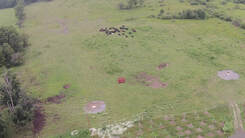CONSERVATION CORNER
A weekly blog for all things conservation
 Kevin Brown, Ag Resource Specialist, BCCD So you have animals, or you want to get some. You may have 1-2 acres that you can put them on, or you may have 10 acres. To most people, when they look at that much land, they think “That is a lot of land and it will support however many animals I want to have”. Let’s be honest, 3-5 horses on one full acre of ground doesn’t look like much. Neither does 15 cows on a full 10 acres of land. So, you get the number of animals you want and start a farm. All is well. The animals have plenty enough land to roam on. They are comfortable and happy. And when you start supplementing them with hay, you don’t think anything about it. That is how it is supposed to be. Right? Well, no, not really. Not for you or the environment. This really does not work for two reasons. One- If the animals are allowed to roam on this ground at their leisure, eventually there will be bare areas of soil that start to appear. Depending on the animal, some may be faster than others, and some of those areas may be a lot worse than others. If the height of forage in the field gets less than 3”, this area technically becomes what we call a Heavy Use Area or Animal Concentration Area. It is NOT a pasture anymore. So what? Who cares? Well, we all should, for a number of reasons.
The reason that YOU should care is that you are severely restricting the growth of the plants in that area. Plants need a rest period AND they need to remain at least 3” tall at all times in order to have the energy reserves they need for future growth. If you abuse this, plants do not grow well and you will have to feed more stored feed. Again, don’t care? Stored feed costs you time and money to make. You have to cover more acres than you should. If they harvest it on their own (pasturing), there is no expense to you. “Pastures” can easily go from producing 4-5 tons of hay per acre to one, or less, by not managing it correctly. You will spend lot of time and money making up for poor management. If you still want that many animals, you need to find more ground or “barn” them up occasionally and let the grass recuperate. It will put money in your pocket. Two-on the environment end of things, you are continually building nutrients in the soil doing it this way. The end result will be pollution. There are too many nutrients being deposited for the amount of hay being produced, and you made it worse by continually grazing it and cutting yield to 1 ton/acre or less. There are laws that dictate when and where you can have these areas. You can actually be breaking the law if they are not properly managed. (Side note- if you have animals, you are required to have a Manure Management Plan. Period. Any animals. Call us. We can help you write one) So, what is the real number to have for animals? Actually, you need at least 2 acres/animal (full grown animal). Yes, 2 acres. 10 cows- 20 acres. 5 horses- 10 acres. This works both for supplying the amount of forage they need during the summer, based on the normal yield we get in this area (if not abused), and the amount of nutrients being deposited to the soil. Less acres means making more hay, and more pollution. The easy way to look at this is that if you are supplementing feed in an average year when grasses continue to grow, you have too many animals or not enough ground. And you are building nutrients to pollution levels by doing so.
0 Comments
Leave a Reply. |
AuthorsVarious staff at the Bradford County Conservation District Archives
July 2024
Categories
All
|
|
Bradford County Conservation District
Stoll Natural Resource Center 200 Lake Road, Suite E | Towanda PA 18848 Phone: (570)-485-3144 |
